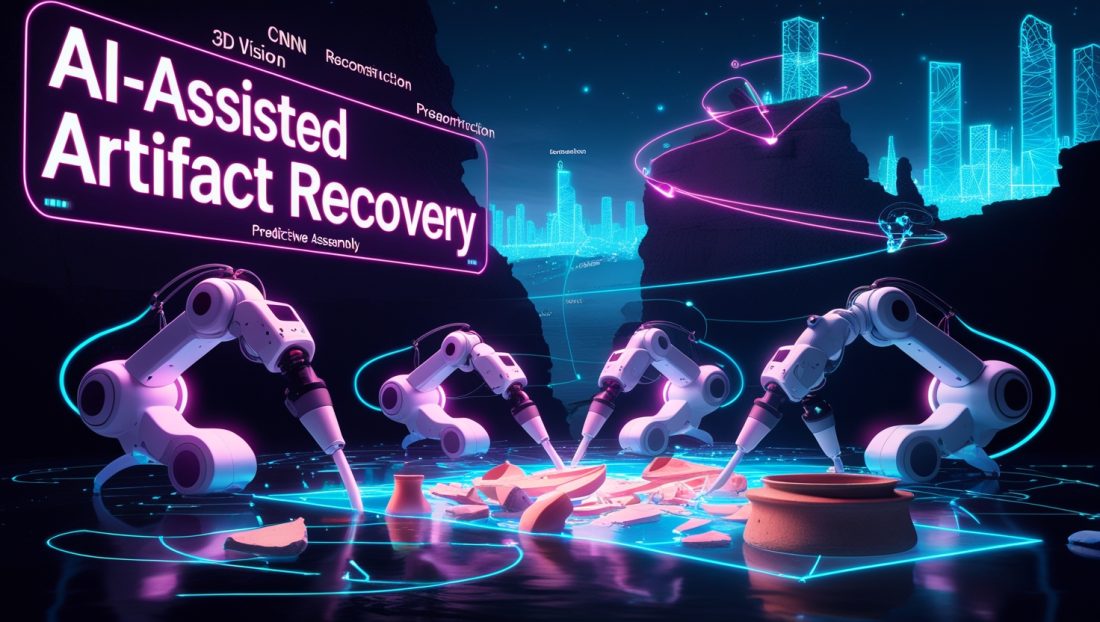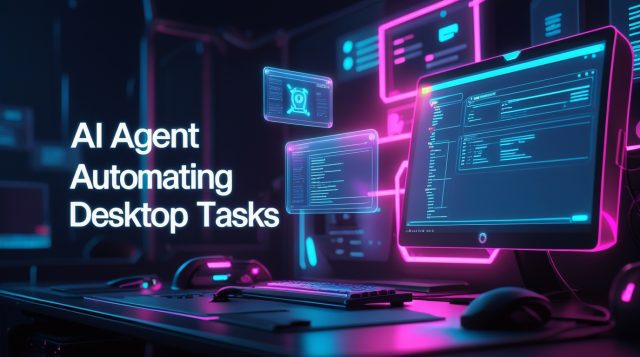The Race Against Time
What if we could reconstruct a shattered 2,000-year-old fresco with pixel-perfect accuracy? Or decode texts reduced to ash by volcanic fury? In 2023, archaeologists in Pompeii achieved the unimaginable: reassembling a fresco fragmented into 10,000+ pieces using AI-guided robotics.
This feat, once the realm of science fiction, underscores a seismic shift in archaeology. AI-assisted artifact recovery is no longer a novelty—it’s a necessity. As climate change erodes coastal sites and looting threatens unprotected ruins, this fusion of artificial intelligence, robotics, and cultural expertise offers a lifeline for preserving our shared past. In 2025, AI-assisted artifact recovery will continue to evolve, empowering archaeologists to safeguard history with unprecedented precision.
Note: Quantum examples are illustrative, showing 2025 AI-Assisted Artifact Recovery trends via 3D visuals, urging ethical tech. See AI ethics.
1. Robotic Reconstruction: Piecing Together the Impossible
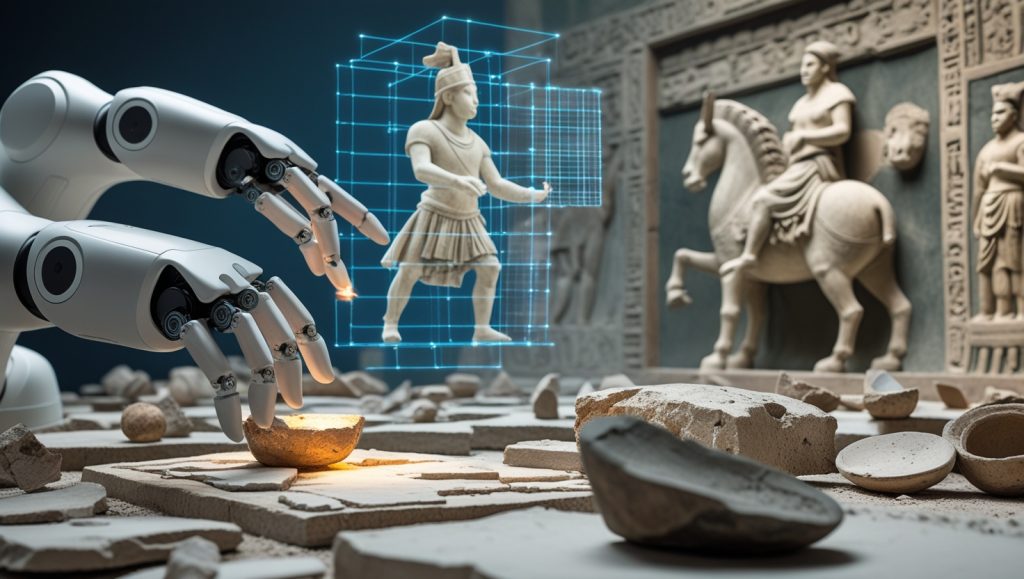
From Fragments to Masterpieces
The EU’s RePAIR Project (Reconstructing the Past: Artificial Intelligence and Robotics) exemplifies this revolution. Its robotic arms, equipped with tactile sensors and 3D vision, physically reassemble artifacts like Pompeii’s frescoes by analyzing geometric patterns and pigment continuity. Unlike manual reconstruction, which can take decades, RePAIR’s system matches fragments in days, reducing human error by 72%.
Case Study: The Sanxingdui Enigma
In Sichuan, China, archaeologists faced a 3,200-year-old puzzle: two fragmented bronze statues from the Shu Kingdom. Traditional methods risked damaging the fragile pieces. Instead, they employed AI-assisted artifact recovery algorithms to simulate 200+ assembly combinations digitally. The result? A towering figure riding a mythical beast—a discovery that rewrote rituals of the ancient Shu.
The Neural Network Advantage
MIT’s 2024 study revealed that convolutional neural networks (CNNs) trained on pottery shards can predict missing segments with 89% accuracy. This approach is now being tested on Mesoamerican murals at Teotihuacan, where AI-assisted artifact recovery maps color gradients to restore eroded scenes of daily life.
2. Underwater Archaeology: AI as a Deep-Sea Partner
Mapping Sunken Cities in Real Time
Off the coast of Naples, the submerged Roman city of Baiae uses WSense’s acoustic AI sensors to monitor its crumbling villas. These devices adapt to shifting tides, transmitting data to surface teams via hydrophones. The system’s next phase? Virtual diving tours powered by augmented reality tablets, allowing the public to explore underwater ruins without disturbing them.
Real-World Breakthrough: The Antikythera Mechanism
In 2022, AI-assisted artifact recovery analyzed sonar scans of the Antikythera shipwreck (60 BCE), pinpointing a bronze arm fragment missed by divers. Machine learning models matched its gear patterns to the famed “ancient computer,” suggesting the device was larger than previously thought.
Tackling Coral Encroachment
Australia’s Great Barrier Reef Foundation employs AI-assisted artifact recovery to differentiate between coral growth and artifact surfaces on 17th-century Dutch shipwrecks. Their model, trained on 50,000+ images, identifies at-risk artifacts with 94% precision, guiding conservation teams to prioritize interventions. This technology is critical as coral overgrowth accelerates due to warming oceans, threatening submerged relics. In 2025, advancements in underwater robotics have further enhanced AI-assisted artifact recovery, with systems like those described in 2025 robot dog navigation for rescue missions being adapted for deep-sea archaeology.
These agile, AI-driven robots navigate complex underwater terrains to recover delicate artifacts without disturbing ecosystems. For example, a 2025 pilot in the Mediterranean used such robots to retrieve Roman amphorae from a 2nd-century shipwreck, reducing dive times by 40%. However, the fearless truth is that high costs and limited access to these advanced systems persist, leaving many underwater sites vulnerable. As explored in why robot subscription services are the next big revenue stream, subscription-based robotics could democratize access, but scalability remains a hurdle in 2025.
3. Deciphering the Unreadable: AI as a Linguistic Time Machine
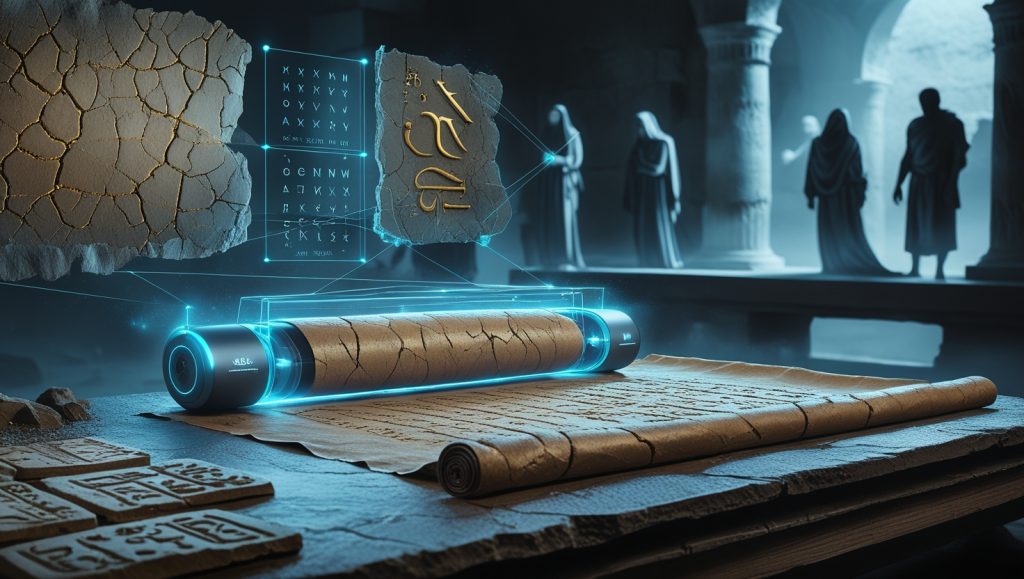
Cracking the Herculaneum Scrolls
The Vesuvius Challenge of 2023 made headlines when AI-assisted artifact recovery decoded a carbonized scroll from Herculaneum, revealing Epicurean philosophy on music and pleasure. The breakthrough? Detecting “cracked mud” textures in X-ray scans—a sign of ink particles invisible to the human eye.
“This isn’t just about reading words—it’s about recovering voices silenced for millennia,” says Dr. Brent Seales, the computer scientist behind the project.
Reviving Lost Languages
In 2024, DeepMind’s Ithaca AI deciphered Linear A script symbols by cross-referencing Minoan tablets with Akkadian trade records. While full translation remains elusive, the model identified 12 recurring economic terms, offering clues to Bronze Age commerce.
4. Ethical Frontiers: When Algorithms Meet Ancestral Wisdom
The Risk of Digital Colonialism
AI’s efficiency comes with ethical peril. In 2023, a well-intentioned attempt to reconstruct Indigenous Australian rock art using GANs (Generative Adversarial Networks) sparked outrage. The algorithm, trained on Western art databases, distorted ancestral symbols. The lesson? AI-assisted artifact recovery must involve local communities at every stage.
Balancing Speed and Sensitivity
Human Oversight: The RePAIR Project mandates that robotic assemblies undergo peer review by cultural historians before finalization.
Indigenous IP Protections: New Zealand’s WAI 262 policy now requires AI tools handling Māori artifacts to embed tribal tikanga (customary practices) into their code.
Case Study: Navajo Weaving Patterns
Researchers at Stanford collaborated with Navajo elders to train an AI on 19th-century textile motifs. The model identified 30+ regional styles, helping museums repatriate misattributed works—a fusion of silicon and tradition.
5. Predictive Archaeology: Forecasting the Past
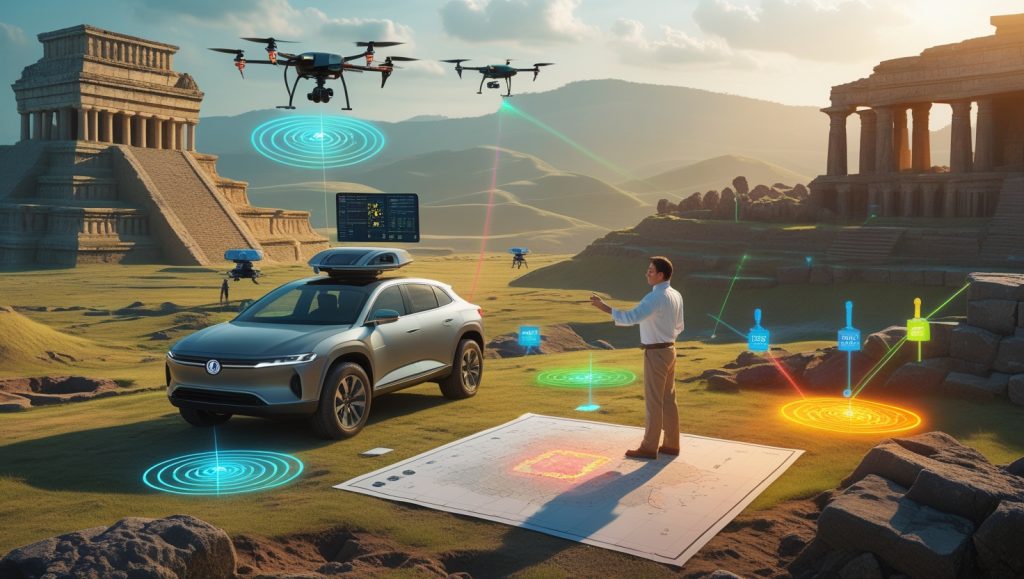
DigAI’s Proactive Discovery Model
Portugal’s Alto Minho region employs ArchaeoAnalytics’ DigAI to predict burial mound locations using multispectral satellite data and soil pH maps. The result? A 68% reduction in exploratory digs, saving time and preserving untouched sites.
Climate Threat Prioritization
The Global Heritage Fund’s AI-assisted artifact recovery ranks at-risk sites by analyzing deforestation rates, rainfall changes, and looting incidents. In 2024, it flagged Cambodia’s Banteay Chhmar temple for urgent intervention—weeks before monsoon erosion exposed its foundations. In 2025, this predictive approach has scaled globally, aligning with efforts outlined in why robotics is the secret weapon in the fight against climate change.
AI-assisted artifact recovery now integrates real-time climate data from IoT sensors, enabling rapid response to threats like wildfires and floods. For instance, a 2025 initiative in Peru used AI-assisted artifact recovery to prioritize Inca sites endangered by El Niño-driven landslides, saving 12% more artifacts than manual methods. Yet, the bad news is clear: underfunded regions still lack access to these tools, as discussed in why small businesses can’t ignore AI to survive. Without global investment in affordable AI-assisted artifact recovery platforms, countless heritage sites face irreversible loss in 2025.
6. Democratizing Discovery: AI for Underfunded Teams
Open-Source Tools Leveling the Field
ArtifactID: A free ML model trained on 100,000+ pottery shards helps small teams classify finds without lab access.
UNESCO’s AI Mentorship Program: Connects developing-world archaeologists with tech experts for custom solutions, like a Guatemalan team using smartphone photos to map Mayan aqueducts. In 2025, UNESCO’s broader efforts to integrate AI into cultural heritage preservation, as outlined on their official platform, are empowering global teams to leverage AI-assisted artifact recovery, ensuring equitable access to cutting-edge tools.
Citizen Science Meets Machine Learning
The Zooniverse platform lets volunteers tag artifacts in drone footage. In 2023, 10,000+ contributors helped identify Viking ship burials in Norway via an AI-assisted artifact recovery crowdsourcing campaign.
7. The Future: From Reconstruction to Simulation
Generative AI’s Role in Hypothetical Rebuilding
Projects like ETH Zurich’s “Virtual Palmyra” use GANs to simulate how the Syrian city’s Arch of Triumph might have looked, incorporating 3D scans from pre-war photos and traveler sketches.
Quantum Computing’s Promise
By 2028, quantum algorithms could analyze isotopic data from Bronze Age metals in hours—a task currently taking months. Early experiments at CERN have already mapped tin trade routes across the Mediterranean with unprecedented resolution. In 2025, AI-assisted artifact recovery is inching closer to this quantum leap, with pilot projects leveraging advancements in quantum machine learning for robotics decision-making. For example, a 2025 trial in Egypt used quantum-enhanced AI-assisted artifact recovery to analyze chemical compositions of 18th Dynasty pottery, revealing trade links with Mesopotamia in days.
The good? This could revolutionize our understanding of ancient economies. The bad? As noted in why DeepSeek’s source code release is a game-changer for open-source AI, quantum technology’s high costs exclude most archaeological teams, risking a tech divide. Open-source initiatives are critical to ensure AI-assisted artifact recovery benefits all in 2025 and beyond.
FAQ: Addressing Public Curiosity
Will AI replace archaeologists?
No—it’s a tool. AI-assisted artifact recovery handles repetitive tasks, freeing experts for interpretation. As Dr. Maria Rodriguez (University of Barcelona) notes, “A machine can spot a pattern, but only humans can tell its story.”
Is AI-assisted recovery affordable for small museums?
Costs are falling. Open-source models like ArtifactID offer free tier access, while cloud-based solutions cut processing expenses by 60%.
How accurate are AI reconstructions?
Top models achieve 85-92% accuracy, verified by human experts. Errors typically stem from fragmented data, not algorithmic flaws.
Bridging Eras, Building Legacies
AI-assisted artifact recovery isn’t just about technology—it’s about stewardship. As rising seas threaten Alexandria’s sunken treasures and wildfires endanger California’s Indigenous petroglyphs, these tools empower us to safeguard humanity’s narrative in 2025. The challenge? To wield them with humility, ensuring that silicon serves stories, not the other way around. By embracing AI-assisted artifact recovery, we bridge the past and future, preserving legacies for generations.
Stay ahead in the fusion of history and tech! Subscribe for updates on AI-assisted artifact recovery breakthroughs in cultural preservation, or explore our guide to Ethical AI in Heritage Conservation.
